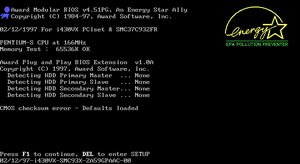(Added POST images for almost all versions and replaced the 6.00PG POST image with a better image) |
mNo edit summary |
||
| (12 intermediate revisions by the same user not shown) | |||
| Line 1: | Line 1: | ||
AwardBIOS | <!-- todo: | ||
* finish the awardbios 2.xx page | |||
* write the pages for 3.xx, 4.xx and 4.2x/4.3x | |||
* re-write the elitebios and powerbios pages | |||
* add the forks to the 6.00pg page and re-write the setup section | |||
* add a segment for workstationbios to the 6.00pg page --> | |||
'''AwardBIOS''', also known as '''Award Modular BIOS''' or '''Phoenix - AwardBIOS''', is a discontinued [[personal computer BIOS]] developed by [[Award Software]] from 1984 to 1998 and by [[Phoenix Technologies]] from 1998 to 2009. | |||
It was officially discontinued by Phoenix on June 30, 2009<ref>https://web.archive.org/web/20100102014331/http://phoenix.com/NR/rdonlyres/41C4EE68-A650-4969-805D-08F8798DF108/0/EOMletter_Award.pdf</ref>, however AwardBIOS ROMs that were compiled/released after that date exist (either as updates for older motherboards that shipped with AwardBIOS or third party BIOS modifications based on older ROMs). In addition; some motherboards that are based on older chipsets/platforms, although released after the discontinuation, still shipped with AwardBIOS. This was usually because the manufacturer only had an AwardBIOS license for that platform and since licensing a new BIOS would cost money and time. | |||
== | Along with this, [[wikipedia:Gigabyte_Technology|Gigabyte]] has also made motherboards with newer chipsets (such as the Intel H55 and H61) that shipped with AwardBIOS even though it had been discontinued. However this was only because that instance was [[AwardBIOS v6.00PG#Gigabyte fork (early-2000s - 2017)|a fork that they were developing independently]]. Sometime in 2012, specifically with the release of Intel's 7-series chipsets, Gigabyte switched to [[AMI Aptio]] for their newer platforms. However some of their newer motherboards based on older chipsets continued to use the AwardBIOS fork, with the last known motherboard released with this fork being the [https://www.gigabyte.com/us/Motherboard/GA-78LMT-USB3-R2-rev-10#kf GA-78LMT-USB2-R2] with the AMD 760G chipset, with its first and only available BIOS ROM being compiled on November 8, 2017. | ||
In | |||
== Award Software == | |||
[[File:Award Software logo.png|thumb|The Award Software logo]] | |||
Award Software International Inc. was a software development company founded in 1983 by Rene Vishney and Bob Stillman in [[wikipedia:San_Jose,_California|San Jose, California]]. The company's headquarters were relocated to nearby [[wikipedia:Los_Gatos,_California|Los Gatos]] next year. In 1988, Bob Stillman left the company and the company then continued being held privately by Rene (as chairman of the board) and his wife Deborah Lee Vishney (as CEO). | |||
=== Acquisition by GCH Systems Inc. === | |||
In 1993, the company was acquired by GCH Systems Inc. which was founded by George C. Huang in 1984 in [[wikipedia:Sunnyvale,_California|Sunnyvale, California]]. GCH was officially dissolved on December 16, 2023<ref>https://bizfileonline.sos.ca.gov/api/report/GetImageByNum/216187144179103006213063034162143116038214189110</ref>, 30 years after the acquisition. | |||
=== Unicore Software acquisition === | |||
On June 16, 1997, the company announced the acquisition of the [[wikipedia:North_Andover,_Massachusetts|North Andover, Massachusetts]] based BIOS upgrade provider Unicore Software, Inc.<ref>https://web.archive.org/web/19971122054540/http://www.award.com/Press/97_6_16.htm</ref>, which has acquired the [[MR BIOS]] developer company [[MR BIOS#Microid Research Inc. (MRI)|Microid Research Inc.]] some time prior. With this acquisition, Award Software became the parent of both companies and also acquired the rights to [[MR BIOS]]. | |||
=== Merge with Phoenix Technologies and dissolution === | |||
On April 16, 1998, [[Award Software]] announced a merger agreement with [[Phoenix Technologies]] to create a $100 million BIOS development company<ref>https://web.archive.org/web/19981202192141/http://www.award.com/press/98_4_15m.htm</ref>. Under the agreement, Phoenix would be the surviving corporate identity and Award would be dissolved. The agreement was completed on September 28th of that year and Award Software was officially dissolved on February 9, 2001<ref>https://bizfileonline.sos.ca.gov/api/report/GetImageByNum/012154091108164216177218230180091169153208140005</ref>, while GCH Systems owner George Huang became the board member and vice chairman at Phoenix until March 2006<ref>https://www.aaapoe.net/ntu/DrGeorgeHuang/DrGeorgeHuang.pdf (Page 4)</ref>. | |||
== List of known versions == | == List of known versions == | ||
{| class="wikitable" style="width:100;%" | {| class="wikitable" style="width:100;%" | ||
!Version | !Version | ||
!Release date | !Release date | ||
| Line 17: | Line 31: | ||
!Notes | !Notes | ||
|- | |- | ||
|AwardBIOS 1.xx | |[[AwardBIOS 1.xx]] | ||
|1984 | |1984 | ||
|''Not available'' | |''Not available'' | ||
|Confirmed | |Confirmed to exist based on strings from [https://www.pcorner.com/list/DIAGS/BIOS32X.ZIP/BIOSSIG.DBA/ a BIOS version database] . No ROM files or pictures are currently available and not much is known about it. | ||
|- | |- | ||
|AwardBIOS 2.xx | |[[AwardBIOS 2.xx]] | ||
|1985 | |1985 | ||
|[[File:AwardBIOS 2.07 POST.png|300px]] | |[[File:AwardBIOS 2.07 POST.png|300px]] | ||
| | |Likely the first version with a built-in setup utility, as seen on some later instances. | ||
|- | |- | ||
|AwardBIOS 3.xx | |[[AwardBIOS 3.xx]] | ||
|1987 | |1987 | ||
|[[File:AwardBIOS B3.11.03 POST screen.png|300px]] | |[[File:AwardBIOS B3.11.03 POST screen.png|300px]] | ||
|Siemens-Nixdorf | |A code fork by Siemens-Nixdorf also exists | ||
|- | |- | ||
|AwardBIOS v4.00 | |[[AwardBIOS v4.00]] | ||
|1990 | |1990 | ||
|[[File:Award_Modular_BIOS_v4.00_POST.png|300px]] | |[[File:Award_Modular_BIOS_v4.00_POST.png|300px]] | ||
| | |First version with a blue POST screen | ||
|- | |- | ||
|AwardBIOS v4.20 | |[[AwardBIOS v4.20|AwardBIOS v4.2x/4.3x]] | ||
|1991-1992 | |Circa 1991-1992 | ||
|[[File:AwardBIOS 4.20 BIOS POST.png|300px]] | |[[File:AwardBIOS 4.20 BIOS POST.png|300px]] | ||
| | |Usually seen with the version number v4.20. Other odd-numbered versions (such as v4.26, v4.28, v4.32 etc.) can also be seen on some Gateway 2000 computers, however this is likely just a modification made by Swan/Anigma (who made the motherboards for those computers). | ||
|- | |- | ||
| | |[[Award EliteBIOS|Award EliteBIOS (v4.5x/4.6x)]] | ||
|1993 | |1993 | ||
|[[File:AwardBIOS_4_50Blue.png|300px]] | |[[File:AwardBIOS_4_50Blue.png|300px]] | ||
[[File: | [[File:AwardBIOS v4.51PG POST.png|300px]] | ||
| | |Commonly seen with a black POST screen, although earlier instances of v4.50 used the blue POST screen seen with v4.00/4.2x/4.3x. Later instances of v4.50, along with newer versions such as v4.50G, switched to a black POST screen. | ||
|- | |- | ||
|[[Award PowerBIOS]] | |[[Award PowerBIOS]] | ||
|1994(?) | |1994(?) | ||
|[[File:AwardBIOS_Power1_00.png|300px]] | |[[File:AwardBIOS_Power1_00.png|300px]] | ||
| | |Internally labelled as AwardBIOS v5.00. Usually seen on embedded computers and is very uncommon. | ||
|- | |- | ||
|[[AwardBIOS v6.00PG]] | |[[AwardBIOS v6.00PG]] | ||
|1998 | |1998 | ||
|[[File:Phoenix - AwardBIOS v6.00PG POST.png|300px]] | |[[File:Phoenix - AwardBIOS v6.00PG POST.png|300px]] | ||
|Codenamed "Medallion". | |Codenamed "Medallion". It was released shortly before the Award - Phoenix merger, therefore it was maintained by Phoenix for most of its life cycle. Code forks from ASUS and Gigabyte also exist. An edition called [[AwardBIOS v6.00PG#WorkstationBIOS|WorkstationBIOS v6.00PG]] was also released around 2003. | ||
|} | |} | ||
== PhoenixNet controversy == | |||
''Main page: [[PhoenixNet]]'' | |||
In 2000, Phoenix released an add-on for [[Award EliteBIOS]] (specifically versions v4.51xx and v4.60xx) and [[AwardBIOS v6.00PG|Medallion]] (v6.00PG) called PhoenixNet. When enabled, it provided various features on a computer with Windows 98 or Millennium Edition installed, including: | |||
* Automatic installation of sponsored software and other applications chosen by the manufacturer on a new installation of Windows 98/ME | |||
* Automatic addition of sponsored hotlinks to the desktop and the installed web browser. | |||
* Changing the default web browser home page and search settings to the ones set by the system manufacturer for consistency with the system language and locale | |||
The add-on was heavily criticized by various PC enthusiasts online since the pre-installed software could be seen as bloatware and due to privacy concerns, the latter especially because it was noticed that PhoenixNet connected to the Phoenix home page on every startup when enabled. | |||
Phoenix discontinued the add-on sometime in 2001, citing "the demise of the Internet advertising market" as the reason.<ref>https://www.cexx.org/phoenix.htm</ref> | |||
Latest revision as of 11:40, 31 October 2024
AwardBIOS, also known as Award Modular BIOS or Phoenix - AwardBIOS, is a discontinued personal computer BIOS developed by Award Software from 1984 to 1998 and by Phoenix Technologies from 1998 to 2009.
It was officially discontinued by Phoenix on June 30, 2009[1], however AwardBIOS ROMs that were compiled/released after that date exist (either as updates for older motherboards that shipped with AwardBIOS or third party BIOS modifications based on older ROMs). In addition; some motherboards that are based on older chipsets/platforms, although released after the discontinuation, still shipped with AwardBIOS. This was usually because the manufacturer only had an AwardBIOS license for that platform and since licensing a new BIOS would cost money and time.
Along with this, Gigabyte has also made motherboards with newer chipsets (such as the Intel H55 and H61) that shipped with AwardBIOS even though it had been discontinued. However this was only because that instance was a fork that they were developing independently. Sometime in 2012, specifically with the release of Intel's 7-series chipsets, Gigabyte switched to AMI Aptio for their newer platforms. However some of their newer motherboards based on older chipsets continued to use the AwardBIOS fork, with the last known motherboard released with this fork being the GA-78LMT-USB2-R2 with the AMD 760G chipset, with its first and only available BIOS ROM being compiled on November 8, 2017.
Award Software

Award Software International Inc. was a software development company founded in 1983 by Rene Vishney and Bob Stillman in San Jose, California. The company's headquarters were relocated to nearby Los Gatos next year. In 1988, Bob Stillman left the company and the company then continued being held privately by Rene (as chairman of the board) and his wife Deborah Lee Vishney (as CEO).
Acquisition by GCH Systems Inc.
In 1993, the company was acquired by GCH Systems Inc. which was founded by George C. Huang in 1984 in Sunnyvale, California. GCH was officially dissolved on December 16, 2023[2], 30 years after the acquisition.
Unicore Software acquisition
On June 16, 1997, the company announced the acquisition of the North Andover, Massachusetts based BIOS upgrade provider Unicore Software, Inc.[3], which has acquired the MR BIOS developer company Microid Research Inc. some time prior. With this acquisition, Award Software became the parent of both companies and also acquired the rights to MR BIOS.
Merge with Phoenix Technologies and dissolution
On April 16, 1998, Award Software announced a merger agreement with Phoenix Technologies to create a $100 million BIOS development company[4]. Under the agreement, Phoenix would be the surviving corporate identity and Award would be dissolved. The agreement was completed on September 28th of that year and Award Software was officially dissolved on February 9, 2001[5], while GCH Systems owner George Huang became the board member and vice chairman at Phoenix until March 2006[6].
List of known versions
| Version | Release date | POST screen | Notes |
|---|---|---|---|
| AwardBIOS 1.xx | 1984 | Not available | Confirmed to exist based on strings from a BIOS version database . No ROM files or pictures are currently available and not much is known about it. |
| AwardBIOS 2.xx | 1985 | 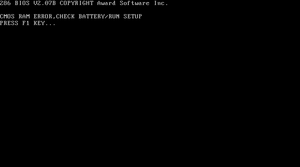
|
Likely the first version with a built-in setup utility, as seen on some later instances. |
| AwardBIOS 3.xx | 1987 | 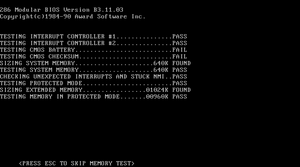
|
A code fork by Siemens-Nixdorf also exists |
| AwardBIOS v4.00 | 1990 | 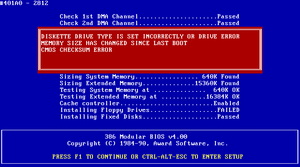
|
First version with a blue POST screen |
| AwardBIOS v4.2x/4.3x | Circa 1991-1992 | 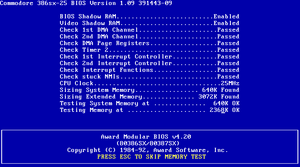
|
Usually seen with the version number v4.20. Other odd-numbered versions (such as v4.26, v4.28, v4.32 etc.) can also be seen on some Gateway 2000 computers, however this is likely just a modification made by Swan/Anigma (who made the motherboards for those computers). |
| Award EliteBIOS (v4.5x/4.6x) | 1993 | 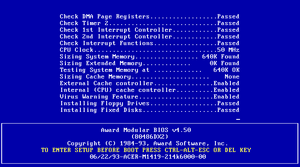
|
Commonly seen with a black POST screen, although earlier instances of v4.50 used the blue POST screen seen with v4.00/4.2x/4.3x. Later instances of v4.50, along with newer versions such as v4.50G, switched to a black POST screen. |
| Award PowerBIOS | 1994(?) | 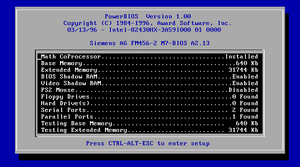
|
Internally labelled as AwardBIOS v5.00. Usually seen on embedded computers and is very uncommon. |
| AwardBIOS v6.00PG | 1998 | 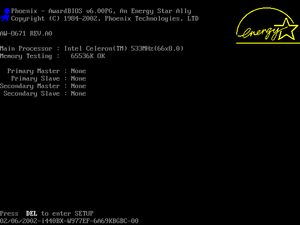
|
Codenamed "Medallion". It was released shortly before the Award - Phoenix merger, therefore it was maintained by Phoenix for most of its life cycle. Code forks from ASUS and Gigabyte also exist. An edition called WorkstationBIOS v6.00PG was also released around 2003. |
PhoenixNet controversy
Main page: PhoenixNet
In 2000, Phoenix released an add-on for Award EliteBIOS (specifically versions v4.51xx and v4.60xx) and Medallion (v6.00PG) called PhoenixNet. When enabled, it provided various features on a computer with Windows 98 or Millennium Edition installed, including:
- Automatic installation of sponsored software and other applications chosen by the manufacturer on a new installation of Windows 98/ME
- Automatic addition of sponsored hotlinks to the desktop and the installed web browser.
- Changing the default web browser home page and search settings to the ones set by the system manufacturer for consistency with the system language and locale
The add-on was heavily criticized by various PC enthusiasts online since the pre-installed software could be seen as bloatware and due to privacy concerns, the latter especially because it was noticed that PhoenixNet connected to the Phoenix home page on every startup when enabled.
Phoenix discontinued the add-on sometime in 2001, citing "the demise of the Internet advertising market" as the reason.[7]
- ↑ https://web.archive.org/web/20100102014331/http://phoenix.com/NR/rdonlyres/41C4EE68-A650-4969-805D-08F8798DF108/0/EOMletter_Award.pdf
- ↑ https://bizfileonline.sos.ca.gov/api/report/GetImageByNum/216187144179103006213063034162143116038214189110
- ↑ https://web.archive.org/web/19971122054540/http://www.award.com/Press/97_6_16.htm
- ↑ https://web.archive.org/web/19981202192141/http://www.award.com/press/98_4_15m.htm
- ↑ https://bizfileonline.sos.ca.gov/api/report/GetImageByNum/012154091108164216177218230180091169153208140005
- ↑ https://www.aaapoe.net/ntu/DrGeorgeHuang/DrGeorgeHuang.pdf (Page 4)
- ↑ https://www.cexx.org/phoenix.htm
